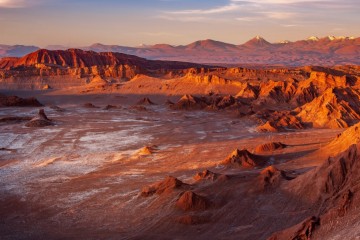
Atacama Desert
The place for star gazing, geysers, moon-like landscapes and floating on salt lakes, discover the beauty of Atacama Desert from San Pedro de Atacama
The salt flats of Bolivia, Chile, and Argentina stand out as some of the most impressive destinations for travellers seeking surreal beauty and cultural immersion in South America. Join us on a comparative journey as we delve into the distinct characteristics of the salt flats in each country.
Unbeknownst to many, South America is the salt flats capital of the world. Not only is the continent home to the largest and most famous salt flats of all – that would be Bolivia's Salar de Uyuni – but expansive and equally enchanting salt flats are also found in Chile and Argentina. These natural wonders, combined, make up the planet’s largest salt flats surface area. That’s one extraordinary South American accolade you don’t often hear about!
So, if the continent is blessed with spectacular salt-encrusted regions, the obvious question usually follows: “Which Salt Flats are best to visit in South America?”
We put Bolivia, Chile and Argentina to the test, offer a comprehensive breakdown of what makes each region unique and help you decide which South American salt flats you should add to your next tour itinerary.
But first, some cool info!
A salt flat is a naturally occurring geographical formation in which an ancient sea has become landlocked through the evolution of our planet. With time and increasing temperatures, the water gradually evaporates, leaving behind a breathtakingly dazzling carpet of glistening salt.
On paper, salt flats might sound like arid and uninteresting regions. In reality, however, the experience of visiting one couldn't be more mesmerising. Salt flats capture nature's incredible splendour, creating captivating backdrops for outstanding travel photography. And because no two salt flats are created equal, the experience is never comparable. Some salt flats are immensely barren expanses of endless horizons, which evoke a sense of otherworldliness. Others do the complete opposite, nurturing many wildlife species that have managed to perfectly adapt to the harsh environment.
And when just enough rain falls on an impenetrable salt lake, the visual effect can be jaw-dropping.
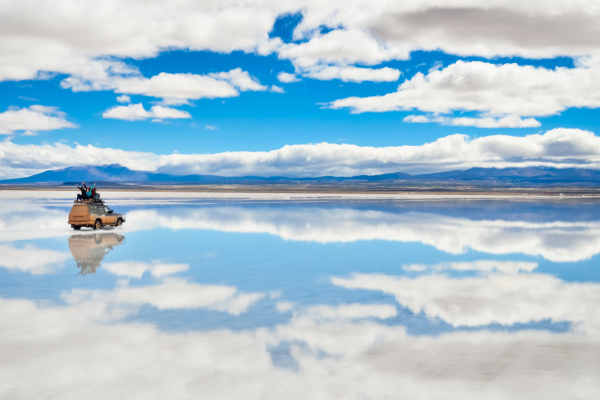
Salar de Uyuni in Bolivia
Bolivia’s Salar de Uyuni is undoubtedly South America's most famous salt flat. With a surface area of 12,000sq.km., it is also the largest by far. Argentina's stunning Salinas Grande comes in at about half the size – yet is still the world’s third-largest. Chile’s ethereal Salar de Atacama, part of the greater Atacama Desert, is about half that still.
Yet size isn’t what matters when it comes to visiting salt flats. After all, you will likely never have enough time on tour to see all 12,000sq.km. of Uyuni’s striking wonder. Instead, you'll want to consider accessibility and convenience, especially if your itinerary of South America is limited to one region.
Bolivia's Salar de Uyuni is revered for its remoteness and awe-inspiring vastness. Tours suit adventurous travellers, photographers and nature lovers who love to be overwhelmed by intense landscapes. A side trip to Salar de Uyuni is ideal if you are planning to visit the central Andes – Peru and Bolivia. But you’ll need extra days on your itinerary. To do Salar de Uyuni justice, you’ll want to dedicate at least two to three days for a traverse by 4WD. This is when the colossal size of the salt flats is palpably felt.
Chile’s Salar de Atacama offers a greater array of highlights, combining salt flats with diverse natural landscapes. The vast white salty plains are framed by a chain of multi-hued mountains and the deep arid canyons of the Atacama Desert. The eclectic landscapes lead to many activities, including 4WD touring, horseback riding, hiking to geysers and extinct volcanoes, and stargazing evenings. The Atacama is one of the world's best southern hemisphere stargazing spots, home to several world-class observatories. If you are including the Atacama Desert on your Chile tour itinerary, then a side tour of the salt flats is a must! Moreover, if you like the idea of crossing Salar de Uyuni and the Altiplano by road, then know you’ll end up at the base town for tours of Salar de Atacama. This is a great way to soak up a 2-for-1 salt flats experience.
Tours of Argentina's Salinas Grandes emphasise cultural immersions and spectacular landscapes. Given its proximity to major cities, visits are well-suited for travellers who want to experience the salt flat phenomenon in a shorter period. Salinas Grandes are arguably the most accessible and convenient salt flats in South America, so they’re an excellent choice for those seeking a shorter excursion, although – naturally – this works mostly if you are planning to visit Argentina.
Let's have a look at each in more detail.
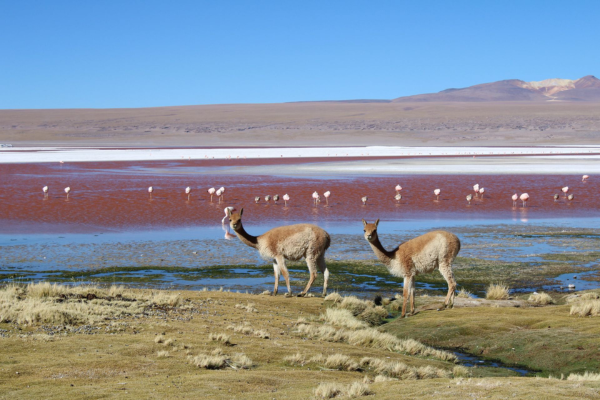
Salt Flats in South America
Bolivia's salt flats are quite remote, with a minimal level of tourist infrastructure and an altitude of 3,600masl. The logistics of planning a visit can be bothersome, yet the overall experience remains one of the most coveted in South America – for very outstanding reasons. This place is simply magical!
How to get there: The main springboard for tours to Salar de Uyuni is the small remote town of Colchani, near Uyuni, located high on the Bolivian altiplano. Uyuni has a small domestic airport with daily services to La Paz, Bolivia’s capital.
How to visit Salar de Uyuni: Tour options from Uyuni include day trips to the salt flats (that only offer a taste of the surreal landscapes for a few hours), two-day loop tours that start and end in Uyuni and (the most popular option) 3-day tours that traverse Salar de Uyuni and the Bolivian Altiplano, starting in Uyuni and ending in San Pedro de Atacama, just over the border in Chile.
Things to see and do: Discover highlights like Isla Incahuasi (and its ginormous cacti) and the Salt Palace Hotel, as well as colourful lagoons, geysers, and hot springs. Note that the time of year you visit, and the amount of water on the salt flats, determine just how far into the salt flats you can explore.
Best time to visit: The best time to visit Salar de Uyuni is during the dry season from May to October when the weather is clear, and the salt flats are easily explored. June and July, in particular, offer ideal weather and remarkable perspectives. August usually sees typically windier and colder conditions. For those breathtaking mirror-like reflections, however, you’ll want to visit Salar de Uyuni during the rainy season from December to February. Do note tha,t at this time, the salt flats are more challenging to explore thoroughly (Isla Incahuasi is typically inaccessible, for example) and cannot be traversed so shorter tours are offered.
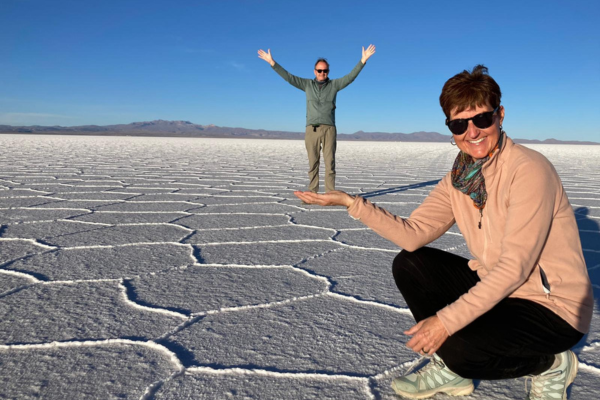
Salar de Uyuni Bolivia
Framed by the Atacama Desert, merely 50km south of San Pedro, is where you’ll find Chile’s largest salt flat. Salar de Atacama is nestled amid surreal landscapes, with high volcanic peaks surrounding it on all sides. The region’s salt flat is renowned for its remarkable biodiversity, as it serves as a vital habitat for several species of resident and other migratory birds.
How to get there: The base town for Atacama visits is San Pedro de Atacama in Chile's far north, a remote town which was once the most thriving oasis stop-over for workers travelling to and from the region’s famed nitrate mines. Today, San Pedro acts as a springboard for Atacama adventures. To reach it, you'll need to take a flight from Santiago to Calama and then about an hour’s drive. San Pedro also happens to be the 'end' town of Salar de Uyuni tours, so combining the two in one whirlwind trip is a genial way to stretch your salt flats journey.
Things to see and do: Tuyajto and Chaxa lagoons, Atacama Salt Lake and its geothermal fields, and extraordinary landscapes. The Atacama Desert offers a myriad of highlights, too, including the Valley of the Moon (named so due to its lunar-like landscapes) and Cejar Lagoon, a turquoise lake framed by crystallized salt that appears as a vision in the dry and desolate landscape. The water is freezing, but we bet you’ll enjoy taking a soak here – or rather, a float. The lagoon’s high salt content (around 20%) makes you float like a feather! Here, you can also soak up spellbinding sunsets.
Best time to visit: The world's driest desert and salt flats don't suffer from rainy season disruptions like Salar de Uyuni, so they're theoretically year-round destinations. However, the coldest winter months can be quite brutal, so the recommended best time to visit is in Spring and Summer – from September through to February. If you're a buddying astronomer, you might want to put up with the freezing temps of June and July. These months boast the clearest skies of the year and the best for specialised star-gazing tours.
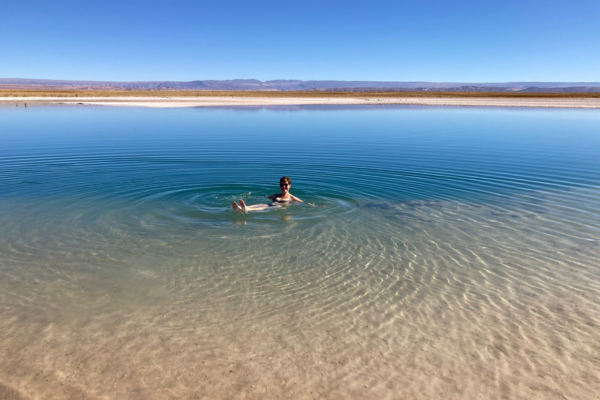
Viva's Destination Specialist Pia Knarston, enjoying a dip at Salar de Atacama Chile
Salinas Grandes is another of South America’s awe-inspiring salt flats located in Argentina's northwest. What makes this place unique is its accessibility and proximity to major cities like Jujuy and Salta.
How to get there: Take a direct flight from Buenos Aires to Salta and enjoy a spectacular drive up to the high Andes, to reach the town of Jujuy.
How to visit Salinas Grande: On day trips from Jujuy, which will typically include a stopover at the Quebrada del Toro gorge and the 15th-century ruins of Santa Rosa de Tastil.
Things to see and do: History, culture, nature and plenty of salt! A full-day trip is a comprehensive experience offering a fantastic overview of two of Argentina's most prized provinces.
Best time to visit: Plan your trip for January, February or March if you'd love to experience the mirror-like reflections after the rains. Visit in May-December to explore the parched white plains more extensively.
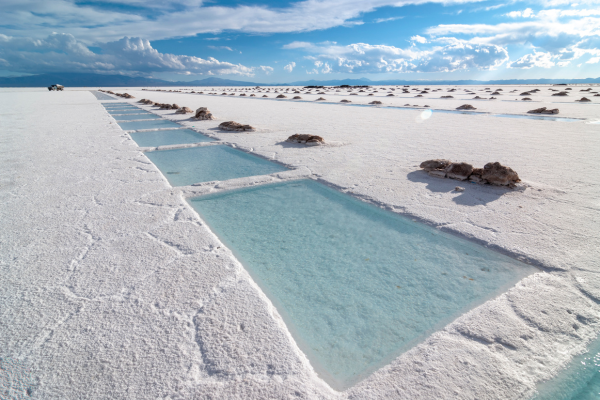
Salinas Grandes Argentina
Beyond their natural beauty, the salt flats of Argentina, Bolivia, and Chile hold significant cultural importance. In Bolivia, the Salar de Uyuni is deeply tied to the indigenous Quechua and Aymara cultures, and you can learn about traditional salt extraction techniques. In Argentina, the Salinas Grandes are an essential part of the local heritage, so ensure your tour includes interaction with local communities to gain insights into their traditional salt mining practices. In Chile, the Salar de Atacama and its surrounding areas exhibit traces of ancient civilisations, such as the Atacameños, who have left behind petroglyphs and archaeological sites.
While Argentina, Bolivia, and Chile's salt flats offer mesmerising landscapes and cultural highlights, each has its unique charm. Whichever salt flat you choose to explore, you will be immersed in a captivating experience that will leave a lasting impression and memories to cherish for a lifetime.
See how we combine a visit to Bolivia and Chile on Viva’s Signature Salt Flats Tour.
Explore the magic of Argentina’s Salta region and salt flats on Viva’s Salta Valley & Canyons Tour.
And if you’d love a more personalised plan, then reach out to one of Viva’s Destination Specialists. They’ll work with you to create a seamless itinerary that includes all the special highlights on your bucket-list, and can advise you on which salt flats would be the best, easiest and most convenient for you to include on your itinerary.
We take care of all the logistics so you don’t have to – and offer 24/7 on-the-ground support once your feet hit South American soil.
Laura PattaraLaura Pattara writes for Viva Expeditions with a special love for all things Latin America. She had guided overland tours across the continent, reached Machu Picchu five times on foot, and even dressed up as a giant toucan for Carnaval. With a degree in languages and two decades of global travel experience behind her, Laura has a long-standing love for the Andes, soaring condors, and a truly delicious empanada. |

The place for star gazing, geysers, moon-like landscapes and floating on salt lakes, discover the beauty of Atacama Desert from San Pedro de Atacama
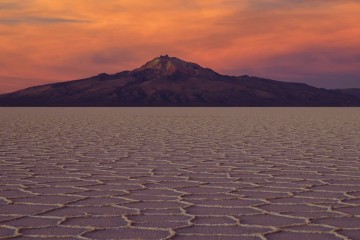
Discover the extraordinary beauty of the Uyuni Salt Flats, the largest in the world - a place that has to be seen to be believed!
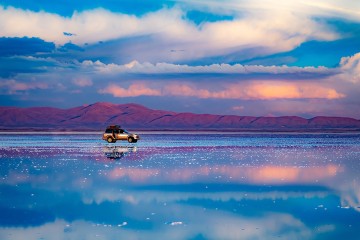
Signature Tours: Refined, Simplified, Perfected
Premium itineraries carefully crafted by destination experts. Take in the very best of South America and Central America, with highly-rated hotels and exclusive authentic experiences.
Journey of awe-inspiring vistas, from the desert landscapes of the Atacama, across the beautiful Salt Flats of Uyuni, to the shores of Lake Titicaca.